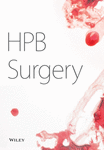Pancreaticogastrostomy After Pancreatoduodenectomy
Abstract
The aim of this study was to evaluate the place of pancreaticogastrostomy (PG) in reducing pancreatic fistula after pancreatoduodenectomy. From January 1988 to June 1991, 32 consecutive patients (mean age, 57 years) were operated on, 25 for malignant disease (78%). The pancreatic remnant was normal in 17 patients (53%) and sclerotic in the others. There was one operative death (3.1%) unrelated to PG. Post-operative complications occurred in five patients (16%). Only two complications were related to PG: 1 patient had anastomotic intra-gastric bleeding and was reoperated on, 1 patient with a normal pancreatic remnant developed a pancreatic fistula (3.1%) treated conservatively.
Reported series of PG, as well as our results, demonstrates that PG is associated with a dramatic decrease of both pancreatic fistula and mortality rates. The risk of anastomotic haemorrhage can be reduced by preventative ligation of submucosal gastric vessels.
In conclusion, PG appears as a simple and reliable method of management of the pancreatic remnant after pancreatoduodenectomy.




